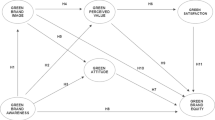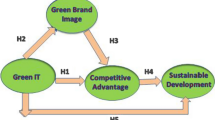Abstract
This research examines the question of how an environmentally proactive hotel can gain competitive distinction by way of ‘green’ branding. It demonstrates that not all green branding options are created equal. The two most widely recognized options, unilateral commitments and participation in voluntary environmental programs, have significant variations in their ability to inform relevant constituencies, achieve external legitimacy and add firm value. To illustrate these points, this research systematically evaluates the efforts of Damaí Lovina Villas, a small boutique Indonesian hotel, to promote its environmental activities by way of developing a green brand. Further, this study develops a framework that other companies can use to assess their green branding options.
Similar content being viewed by others
Notes
This paper draws on-field data gathered between 2003 and 2006, in addition to the instructional case study ‘Sustainability and environmental standards: seeking competitive distinction at Damaí Lovina Villas’, by Nicole Darnall and Mark B. Milstein of Cornell University, which won The Case Association's 2008 Best First Case Award and received an honorable mention at the 2006 oikos Sustainability Case Writing Competition, and is available through the oikos Foundation. The author thanks Glenn Knape of Damaí Lovina Villas and Restaurant for providing data for this analysis.
Unlike most VEPs, ISO 14001 is not specific to an industrial sector, and any type of organization can certify to the standard.
Crop production increases due to composting is not unusual. At the extreme, some studies have shown that compost to agronomic crops can increase crop production as much as 900 per cent (Winter Sydnor and Redente, 2002).
References
Agoda (2007) ‘Go green: Agoda's top 10 eco-friendly hotels’, http://travel.agoda.com/blogs/member_submissions/archive/2007/07/30/go-green-agoda-s-top-10-eco-friendly-hotels.aspx last accessed 6 February 2008.
Akerlof, G. (1970) ‘The market for lemons: quality uncertainty and the market mechanism’, Quarterly Journal of Economics 84: 488–500.
Alchian, A.A. and Demsetz, H. (1972) ‘Production, information costs and economic organization’, American Economic Review 62: 777–795.
Anton, W.R.Q., Deltas, G. and Khanna, M. (2004) ‘Incentives for environmental self-regulation and implications for environmental performance’, Journal of Environmental Economics and Management 48 (1): 632–654.
Bansal, P. and Hunter, T. (2003) ‘Strategic explanations for the early adoption of ISO 14001’, Journal of Business Ethics 46 (3): 289–299.
Barkley, A. (2002) ‘Organic food growth: producer profits and corporate farming’, Paper presented at the ‘Risk and Profit Conference’, Department of Agricultural Economics, Kansas State University, Manhattan, KS, 15–16 August.
Barney, J.B. and Ouchi, W.G. (eds.) (1986) Organizational Economics, San Francisco: Jossey-Bass.
Carmin, J., Darnall, N. and Mil-Homens, J. (2003) ‘Stakeholder involvement in the design of U.S. environmental initiatives: does sponsorship matter?’ Policy Studies Journal 31: 527–543.
Coglianese, C. and Nash, J. (eds.) (2001) Regulating from the Inside: Can Environmental Management Systems Achieve Policy Goals?, Washington, DC: Resources for the Future.
D’Souza, C. (2004) ‘Ecolabel programmes: a stakeholder (consumer) perspective’, Corporate Communications 9: 179–188.
Darnall, N. (2006) ‘Why firms mandate ISO 14001 certification’, Business & Society 45 (3): 354–381.
Darnall, N. and Carmin, J. (2005) ‘Cleaner and greener? The signaling accuracy of U.S. voluntary environmental programs’, Policy Sciences 38: 71–90.
Darnall, N. and Edwards Jr., D. (2006) ‘Predicting the cost of environmental management system adoption: the role of capabilities, resources and ownership structure’, Strategic Management Journal 27 (2): 301–320.
Darnall, N. and Milstein, M. (2007) ‘Sustainability and environmental standards: seeking competitive distinction at Damaí Lovina Villas’, Paper at International Association for Business and Society, 31 May–3 June, Florence, Italy.
Darnall, N. and Sides, S. (2008) ‘Assessing the performance of voluntary environmental programs: does certification matter?’ Policy Studies Journal 36 (1): 95–117.
Fodors Travel (2001) Fodor's Bali and Lombok, 1st edn, New York: Random House.
Ginsberg, J.M. and Bloom, P.N. (2004) ‘Choosing the right green marketing strategy’, Sloan Management Review 46: 79–84.
Larson, A.L. (2000) ‘Sustainable innovation through an entrepreneurship lens’, Business Strategy and the Environment 9 (5): 304–317.
Nair, H. (2007) ‘HVS International’, personal communication, 20 February.
Potoski, M. and Prakash, A. (2005) ‘Covenants with weak swords: ISO 14001 and facilities’ environmental performance’, Journal of Policy Analysis and Management 24 (4): 745.
Reader, L. and Ridout, L. (2002) Rough Guide to Bali & Lombok, London: Rough Guides.
Rivera, J. (2002) ‘Assessing a voluntary environmental initiative in the developing world: the Costa Rican certification of sustainable tourism’, Policy Sciences 35: 333–360.
Rondinelli, D.A. and Vastag, G. (2000) ‘Panacea, common sense, or just a label? The value of ISO 14001 environmental management systems’, European Management Journal 18: 499–510.
Schlichter, S. (2007) ‘Top 5 destinations for eco-tourism: get up and close with the natural world at these hot spots’, 19 April, IndependentTraveler.com, http://www.msnbc.msn.com/id/18215130/, last accessed 26 February 2008.
Suchman, M. (1995) ‘Managing legitimacy: strategic and institutional approaches’, Academy of Management Review 20: 571–610.
Szuchman, P. (2000) ‘Eco-credibility: is your hotel as green as it claims to be?’, Conde Nast Traveller, August: 46.
Walters, P. (2005) ‘Cities question the costs of hybrid cars’, Philadelphia Associated Press, 9 December.
Winter Sydnor, M.E. and Redente, E.F. (2002) ‘Ecosystem restoration’, Journal of Environmental Quality 31: 1530–1539.
Author information
Authors and Affiliations
Rights and permissions
About this article
Cite this article
Darnall, N. Creating a Green Brand for Competitive Distinction. Asian Bus Manage 7, 445–466 (2008). https://doi.org/10.1057/abm.2008.19
Published:
Issue Date:
DOI: https://doi.org/10.1057/abm.2008.19




